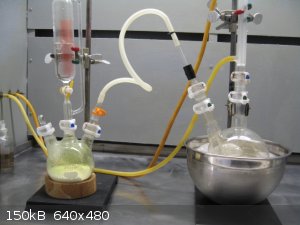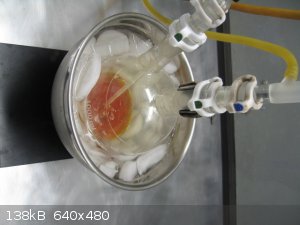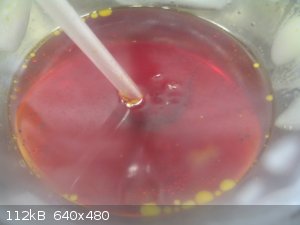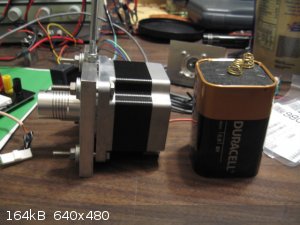Magpie
lab constructor
    
Posts: 5939
Registered: 1-11-2003
Location: USA
Member Is Offline
Mood: Chemistry: the subtle science.
|
|
Preparation of SCl2
Preparation of SCl2 (Sulfur Dichloride) November 17, 2017
A. Introduction
This procedure follows the method of Len1 (ref 1) at 0.57 scale.
TCCA + 3HCl --→ 3Cl2 + cyanuric acid
S2Cl2 +Cl2 --→ 2SCl2
B. Reagents
118g S2Cl2
115.5g TCCA (C3N3Cl3O3) (10% excess)
17.6g HCl (10% excess) as a 15wt% aqueous solution
CaCl2 pellets
0.1g steel wool
perfluoropolyether grease, eg, Krytox
C. Apparatus
a. Reactor
1. Place the S2Cl2 in a 1000ml 2-neck rbf (the reactor) installed in an ice-water bowl.
2. Add 0.1g of steel wool. This forms a small amount of FeCl3 catalyst which substantially enhances the absorption of chlorine (see ref 1).
3. Install a sparge tube in the side-neck of the rbf with opening located a few mm above the bottom of the reactor.
4. Install a reflux condenser on ice-water in the center neck.
b. Chlorine Generator
1. Construct a chlorine generator using a 500ml 2-neck rbf.
2. Attach a 120mL p-e funnel to the center neck of the rbf.
3. Attach an outlet hose to the side-neck. Connect this hose to the sparge tube of the reactor via a drying tube with CaCl2 pellets.
Grease all ground-glass connections with perfluoropolyether (Krytox) grease to prevent the formation of difficult to remove white crud.
The complete apparatus is shown here:

D. Procedure
1. Add the 15% HCl at 1-2 drop/s which will generate chlorine at 150-300mL/min. This will take about 36 minutes.

From Len1 at full scale: “After approximately 400mL of HCl has been consumed in the chlorine generator, substantial reflux commences in the
reagent flask due to the consumption of S2Cl2 and a corresponding drop in the boiling point of the mixture, with chlorine gas starting to appear at
the condenser. Chlorine generation is now stopped and the weight of the deep red liquid product is found to be 324.5g, corresponding to a 100% yield
of SCl2....”
2. Filter the product SCl2 to remove the undissolved steel wool and any elemental sulfur.
E. Results
My yield of SCl2 is 135.5g for a %yield of 75.3%.
F. Discussion
I forgot to install a CaCl2 drying tube in the Cl2 feed to the reactor. This resulted in a small amount of the S2Cl2 being converted to elemental
sulfur per the following reaction:
2S2Cl2 + 2H2O --→ SO2 + 4HCl + 3/8S8
The following photo shows this sulfur floating on the surface.

The picture in Len1’s book, p. 194, is incorrect for this synthesis. I will place a tiny amount of blame on this for my not installing the gas
drying tube.
G. Reference
1. Small-Scale Synthesis of Laboratory Reagents, p. 194, by Leonid Lerner, 2011, CRC Press
Corrections, questions, and comments are welcomed.
[Edited on 18-11-2017 by Magpie]
[Edited on 18-11-2017 by Magpie]
[Edited on 18-11-2017 by Magpie]
[Edited on 18-11-2017 by Magpie]
[Edited on 18-11-2017 by Magpie]
The single most important condition for a successful synthesis is good mixing - Nicodem
|
|
|
AvBaeyer
National Hazard
   
Posts: 644
Registered: 25-2-2014
Location: CA
Member Is Offline
Mood: No Mood
|
|
Magpie,
Nice experiment and write up, as usual. You continue to exceed expectations!
AvB
|
|
|
Magpie
lab constructor
    
Posts: 5939
Registered: 1-11-2003
Location: USA
Member Is Offline
Mood: Chemistry: the subtle science.
|
|
Thank you AvB. I have some more interesting syntheses planned but first must get my new stepper motor electronics repaired.

The single most important condition for a successful synthesis is good mixing - Nicodem
|
|
|
Yellow_Chemistry
Harmless

Posts: 4
Registered: 17-4-2023
Location: Florence, Italy
Member Is Offline
Mood: Highly Unstable
|
|
I have two questions about this procedure
why a stirbar is not used?
It would enhance the contact area between the molten sulfur and the chlorine by breaking the bubbles of chlorine, and by mixing the solution
I don’t think that it will react with SCl2 or S2Cl2 since it is made of teflon
Is it possibile to directly produce SCl2 from sulfur by using your apparatus? (A round bottom flask connected to a reflux condenser instead of a
distillation apparatus)
Technically the products of the two reactions:
2S + 2Cl —> S2Cl2
S2Cl2 + Cl —> 2SCl2
Will be condensed in the condenser and will drop back into the flask where the unreacted S2Cl2 will react with another molecule of chlorine to form
SCl2.
The reaction can be stopped ones the chlorine gas is not adsorbed anymore by the solution
[Edited on 28-11-2023 by Yellow_Chemistry]
|
|
|